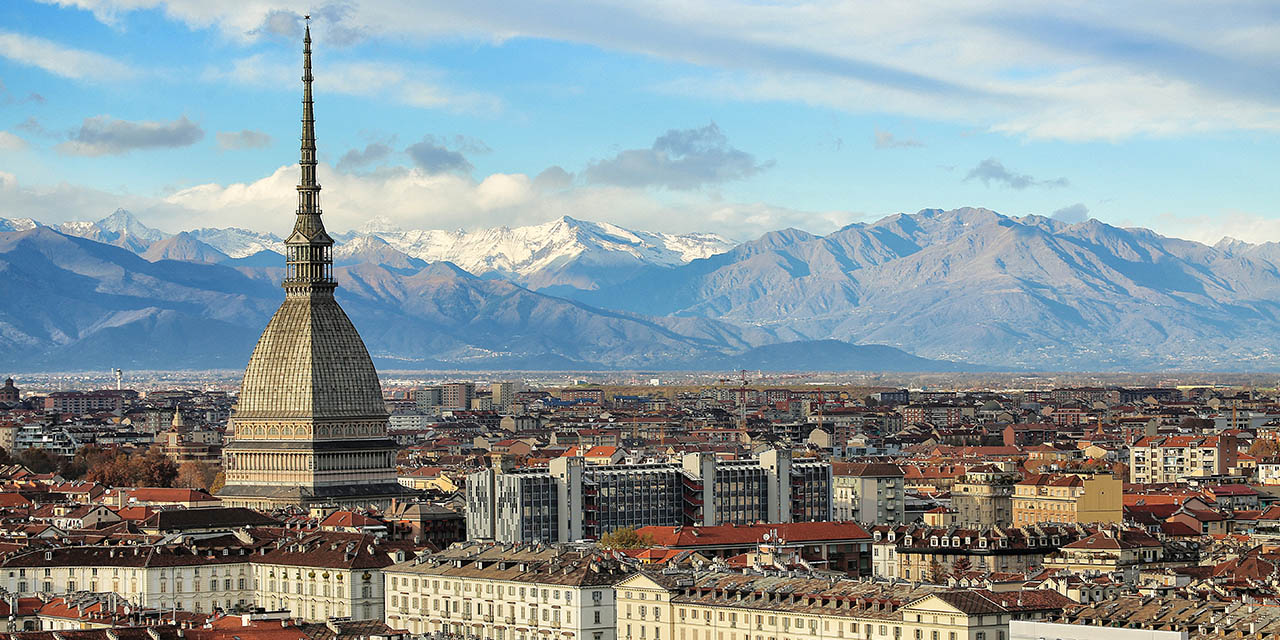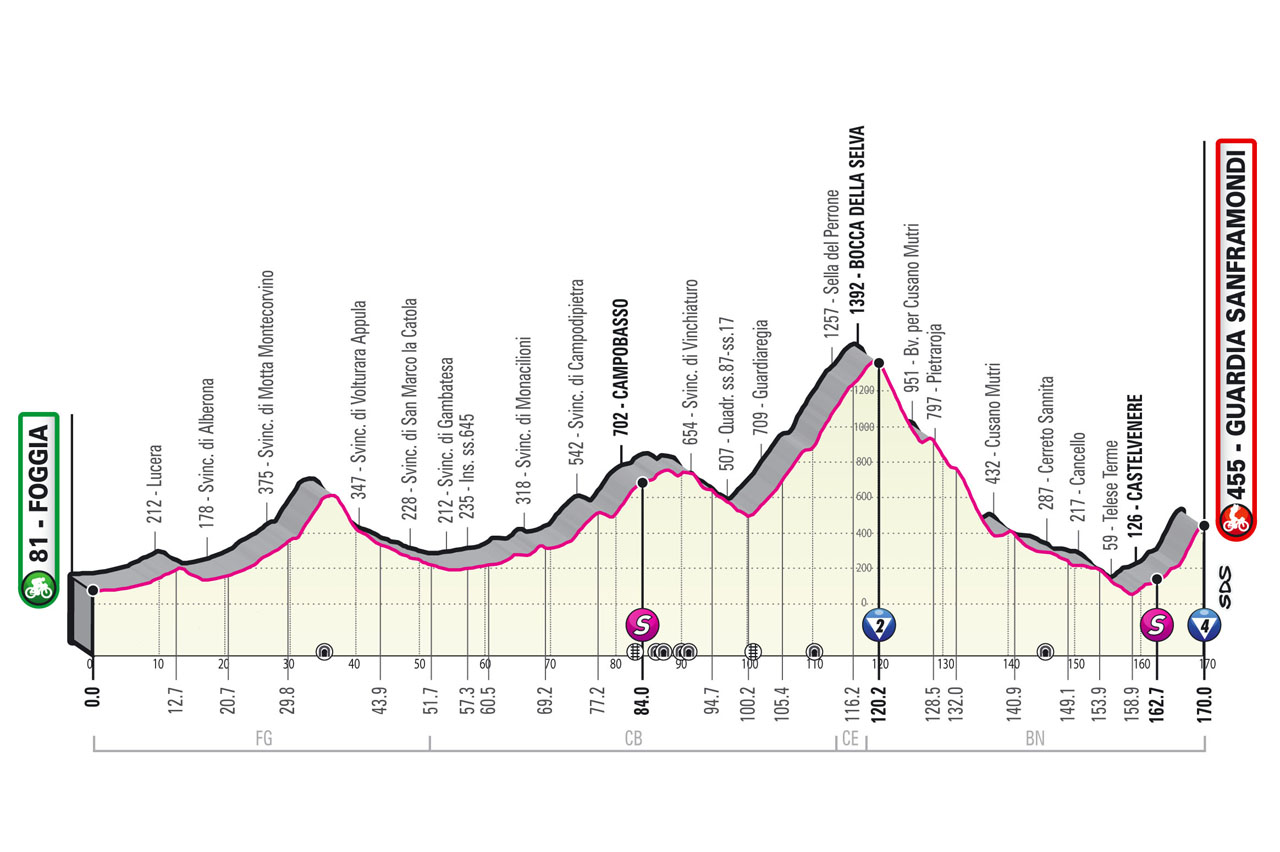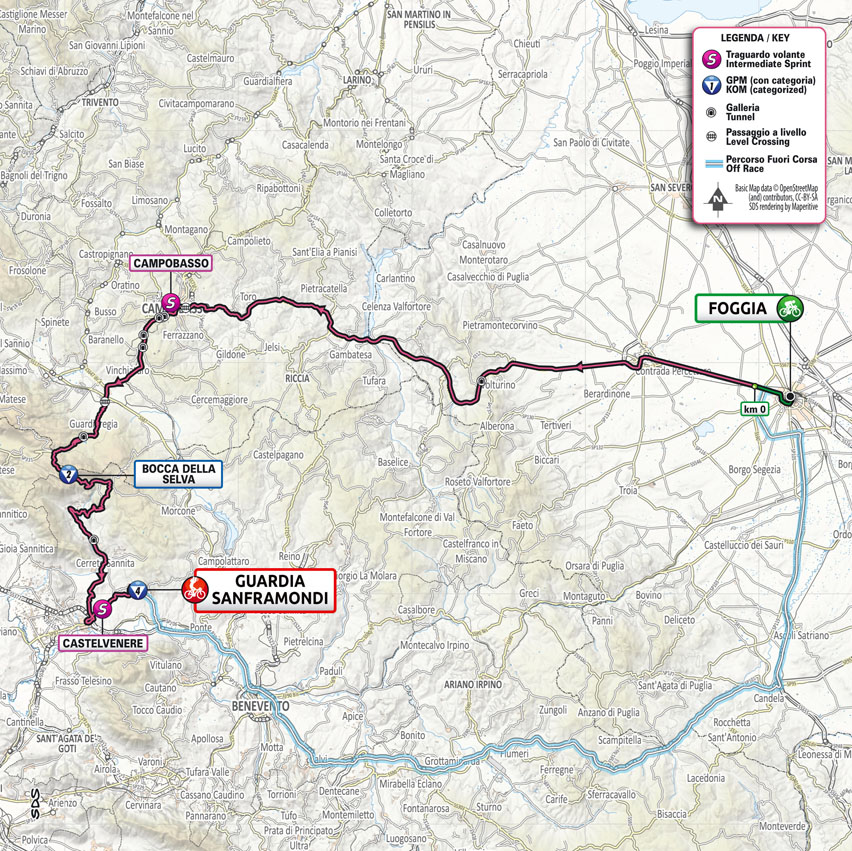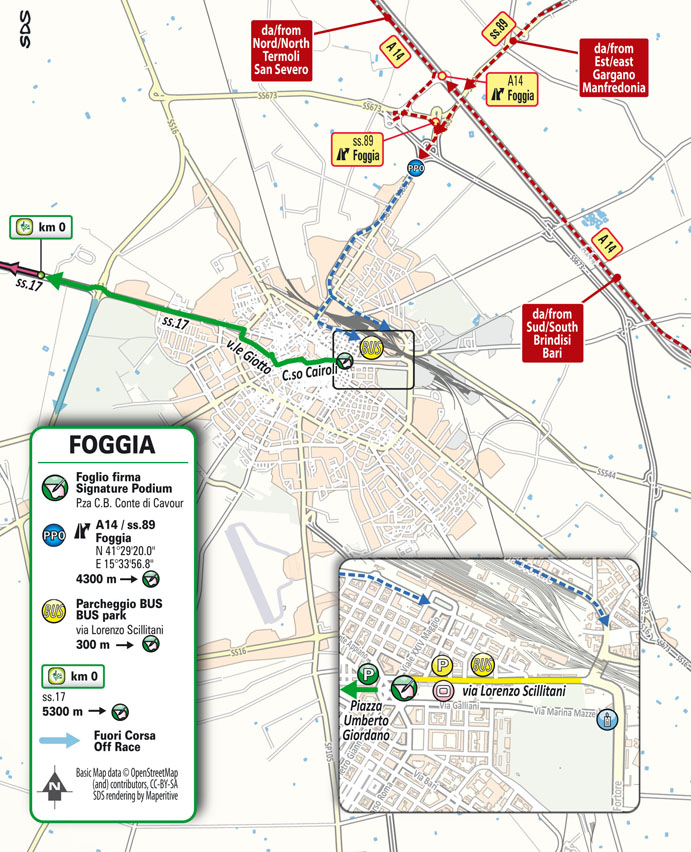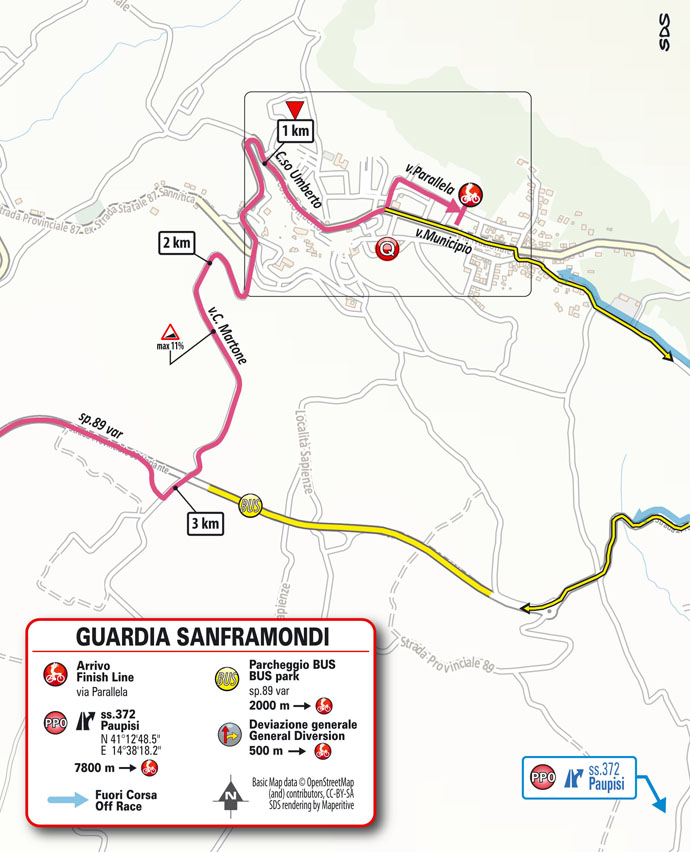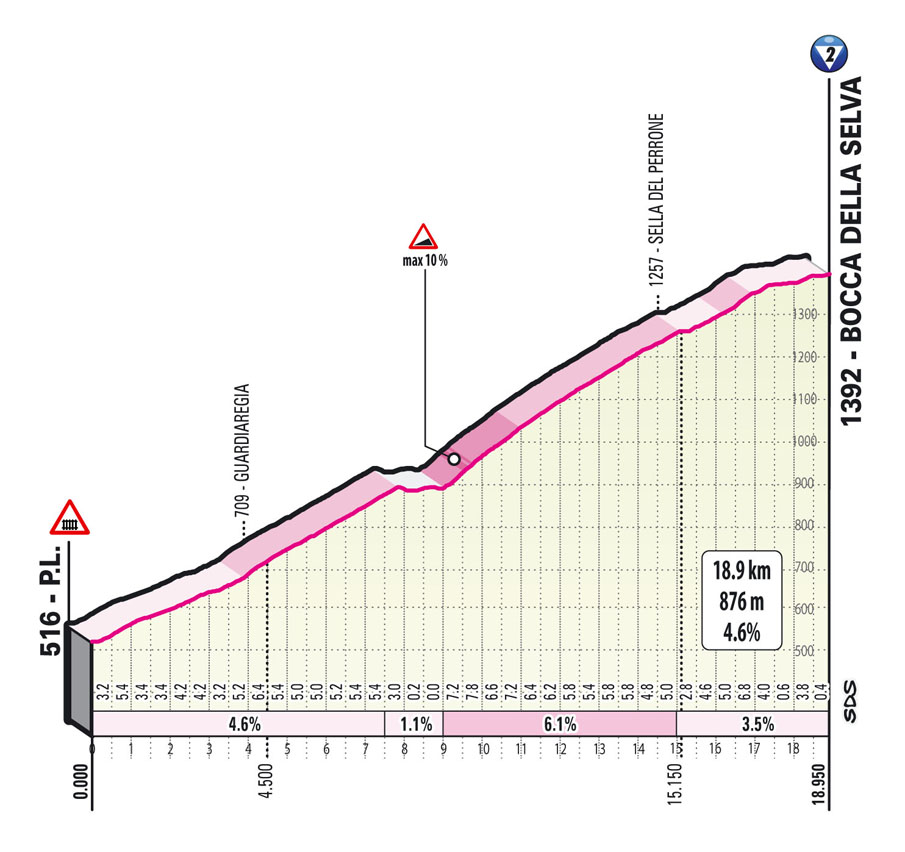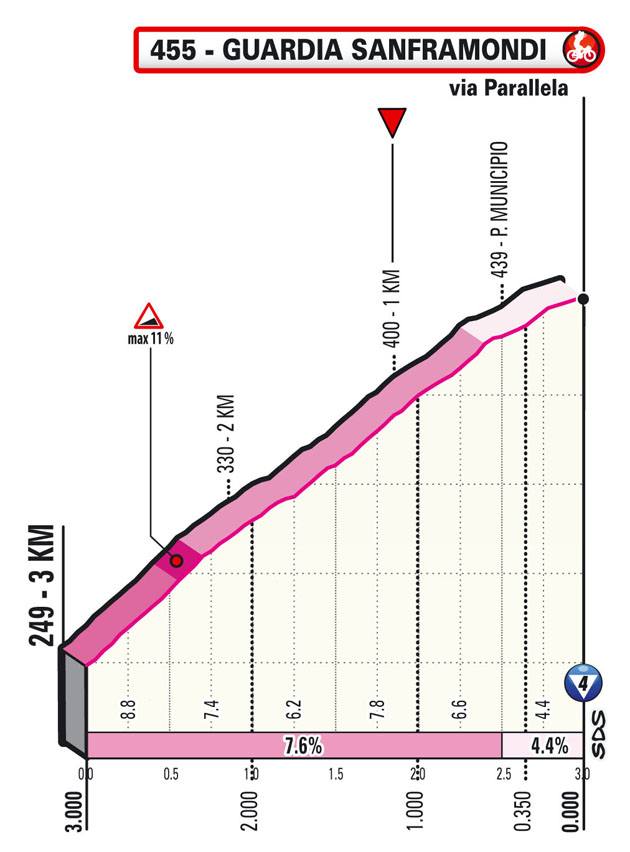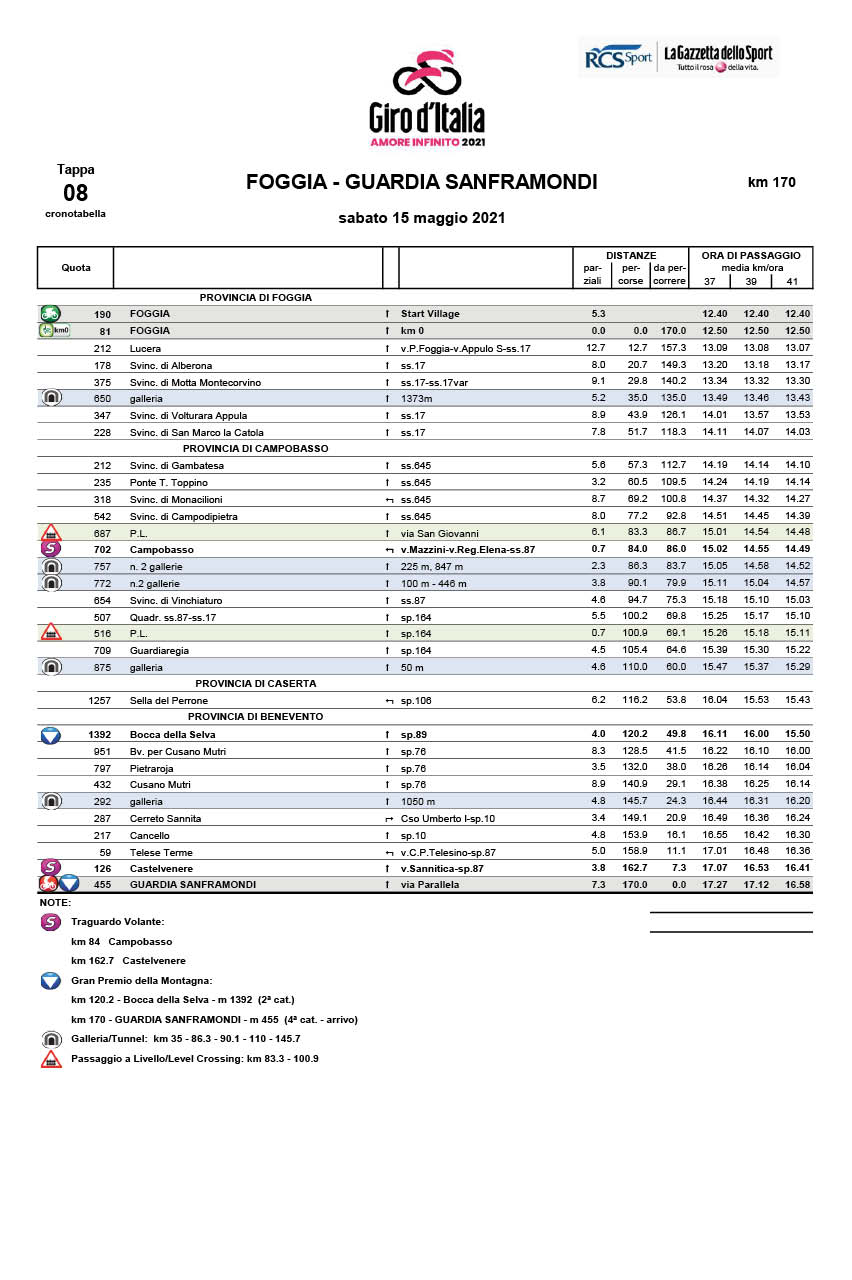profile
map
technical info
This stage across the Apennines features one single lengthy climb, and a steep, challenging kick just before the finish. At first, the route runs along fast and mainly straight roads all the way to Campobasso. The riders then reach the Matese Mountains to negotiate the Bocca della Selva climb (over 20 km), followed by a lengthy descent that ends 10 km before the finish. The route then rises all the way to the finish, with a sharp kick before homing in.
Final kilometres
The closing climb is approx. 3 km long. The gradient hovers around 10% for the first 2 km, with sharper peaks. The pitch returns to milder gradients in Guardia Sanframondi, and then kicks up again with 400 m to go, after a left-hander. The home straight is on tarmac road and on a slight incline.
start / finish
climb detail
final kilometres
itinerary timetable
tourist info
Host city:
Foggia
Overview
“If God knew this land of Puglia, the apple of my eyes, he would have stopped to live here.” This is how Stupor Mundi, the Holy Roman Emperor Frederick II once described the Apulian landscape.
Foggia, lying in the heart of the Apulia Tableland, not only has a vocation for agriculture, but is also a strategic place of innovation and experimentation. With its deeply rooted history, Foggia is the legacy left behind by the epic hero Diomede, the heir to the civilization attributable to the pre-Roman city of Arpi. Its territory is shared among wheat fields, vineyards, stretches of olive trees and lands of tertiary activities.
Shaken by the terrible earthquake in 1731 and the bombings of the Second World War, Foggia has risen from the ashes for more than once.
Gastronomy
Thanks to the synergy with the Center of Agricultural Research and experimentation, the gastronomy of Foggia, from the cultivation of ancient grains to the enhancement of excellence in biodiversity, is a melting pot of tradition and innovation.
Its typical dishes remind one of the city’s origin as farmers, in a land of transhumance where agriculture meets pastoralism.
Among the traditional dishes are “lagane e fave” (fafeijanghe and laghene), a type of pasta similar to tagliatelle, dressed with white bean puree; “pan cotto”, made with slices of bread from Monte Sant’Angelo boiled with vegetables on hand, potatoes and wild rocket, then seasoned with extra virgin olive oil, garlic and bay leaf; “acquasala”, a dish for the poor, made with stale bread softened in water, seasoned with salt, oil, oregano and tomatoes; “pettole”, deep fried bread dough, and “scagliozzi”, fried breaded polenta in a triangular shape; “cardoncelli”, an Easter dish made with tender stalks, lamb and eggs.
Foggian desserts include “taralli neri”, black taralli kneaded with mulled wine and spices, “cartellate”, the carnival fritters served with mulled wine and honey; the typical Christmas dessert “mandorle atterrate”, toasted almonds coated with sugar or chocolate; “pizza di ricotta”, a short-crust pastry made from sheep-milk ricotta for Easter; and “grano dei morti”, cooked grains topped with walnuts, chocolate and pomegranate.
The product of particular merit is the DOC oil for the Coratina, Rotondella, Ogliarola and Peranzana cultivars.
Drinks
On the slopes of the Gargano, San Severo produces its DOC wines, which come in white (produced with white Bombino, white Malvasia and Verdeca), rosé (with Montepulciano and Sangiovese grapes) and red. San SeveroBianco is a pale yellow white wine, with a short-lasting, fruity and floral scent and a dry taste that pairs well with seafood and fresh cheeses.
San Severo Rosato, a rosé carrying a pinkish to ruby hue, is characteristic and has a pleasant fruity aroma and a dry flavor, ideal for aperitifs and first courses. San Severo Rosso, a red wine that, due to aging, boasts a ruby color so intense that it reminds you of red bricks, with an inviting aroma, a dry taste that complements strong flavors such as cured meat, aged cheeses and red meat.
The famous Nero di Troia from the namesake town is produced from the vines of the Dauni Mountains. It is a red wine with an intense color, so full-bodied and structured that in the past it was mixed with vines with a less intense aroma. Meanwhile, the Lucera area produces Cacc ‘e Mmitte (meaning remove and replace) DOCG, DOC and IGT, a red wine whose production is typical of the Daunian Apennines.
Punti di interesse
The city has a very ancient origin tracing back to pre-Roman times, with a close connection to the Trojan hero Diomedes and Dauno, king of the Daunians. Its foundation dates back to the 11th century, when a flaming votive table that floated on the waters of a pond was miraculously discovered in the presence of some shepherds and oxen bowing their knees. Traces of this mythological origin can be found in the emblem of the city, in which three flames are depicted on an azure field. The sacred table, wrapped in seven drapes of Damascus silk, represents a Byzantine icon, the origin of the cult of the Madonna of the Seven Veils, the patron saint of the city.
It was the Norman leader Roberto il Guiscardo who built the first church dedicated to Santa Maria de Focis, on which the standing Cathedral Basilica was built by Guglielmo il Buono, completed by Frederick II. The Holy Roman Emperor also left traces of his passage in the city, promoted to regalis sede inclita imp(er)ialis, having numerous buildings built for the governance of the kingdom and hereby establishing the seat of his Palatium, of which visible traces are preserved in the arch on the Nigri square.
The true jewel of the crown of religious architecture of the seventeenth century is the viamatris of the “Cappellone delle Croci”, which, with its aligned chapels, constitutes a unicum in the entire Southern Italy, located near the intersection of two trails of transhumance.
In the seventeenth century the city was embellished with its Baroque-style monuments: the religious orders constructed the convents of Santa Chiara and Sant’Antonio, while the religious brotherhoods erected religious buildings such as Chiesa della Misericordia or Chiesa dei Morti, recognizable from the skulls that decorate the facade and furnishings.
In the eighteenth century, after the earthquake in 1731, churches located along Via Arpi, the street of art and craft, were built by workers from the Abruzzi. Chiesa dell’Addolorata and the church dedicated to San Giovanni di Dio, now part of the University of Foggia, with decorations on the façade made from the overabundant local stone, are of such a great value that they are recognized as elements of a late Baroque of local extraction.
A little more than a century later, it was the architect Luigi Oberty who gave a neoclassical definition to the city with the arrangement of Villa Comunale and the theater dedicated to the Foggian composer Umberto Giordano.
In the Fascist era, the Great Foggia project took off and the city was at the core of a redevelopment plan of the rural towns and the construction of public and private buildings that celebrated the grandeur of the regime. With this objective in mind, Fontana del Sele was built and inaugurated in 1924. Other structures include the site of the liberty-style Apulian Aqueduct, built in 1926 by the engineer CesareBrunetti, the city hall, Palazzo degli Uffici Statali and Palazzo degli Studi, as well as the prestigious headquarters of the Consorzio di Bonifica, the regulatory body for the agrarian reform.
Among the places of spirituality of the Capitanata lies the Incoronata Sanctuary in the south of the city with its Black Madonna and the convent of Sant’Anna, where Padre Pio of Pietrelcina stayed for seven months in 1916, before reaching San Giovanni Rotondo.
Guardia Sanframondi
Overview
In the heart of Samnium, in the Province of Benevento, there is a road that goes up the hill, from the small hamlet of Castelvenere towards Guardia Sanframondi. As far as the eye can see the road is surrounded by lush vineyards, olive groves and framed, in the distance, by the mountains. Castelvenere, with the most extended vine cultivated area of Southern Italy, and Guardia Sanframondi, with its beautiful memories from ancient times, hold each other’s hand while the view gets lost in the distance.
Guardia Sanframondi is a village of Lombard origin, perched on a hill whose summit is dominated by the Norman Castle built in the 12th century. The village mostly dating back to the 15th century has a medieval urban plan, with the houses joined to each other that climb along the hill spiralling around the ancient castle. Visitors cannot fail to appreciate this stone terrace suspended over the valley and cannot fail to be attracted by the precious architecture of the historical canter.
Gastronomy
The gastronomic tradition of Guardia Sanframondi is linked to its agricultural culture and preserves the taste and flavors of the local land and climate. The local dishes are simple expressions of a complex culture that follows the seasons and values the raw materials with the wisdom that, from generation to generation, reconnects the people to their most ancient traditions.
The excellent olive oil, the local cheese and the cured meats, the homemade pasta, the meat, the baked products, the legumes can always be found on the local tables. Local restaurants offer opportunities to explore this tradition but also to appreciate modern interpretations of the classic local dishes, with interesting ideas, amazing for their simplicity and the freshness of the local flavours.
Some of the traditional dishes are: “Laanella e Fagioli” (Homemade durum wheat tagliatelle in a bean soup); “Zuppa di Grano e Fagioli” (a soup made with wheat berries and beans); the handmade “Cavatelli” (gnocchi) served in a rich meat sauce; Italian Sausage with Broccoli Rabe; the “Frijtora” (pork meat with peppers and potatoes); “R’ Parruozz” (a small loaf of corn flour spiced with hot chilli peppers and flavoured with anchovies); “Cauzun” (Easter stuffed breads) stuffed with wheat or rice that celebrate the Easter festivities; the Christmas Zeppole (fritters), Stuffed Peppers and Stuffed Artichokes filled with a stuffing made with the local bread, cheese and eggs; the Pastiera with its own distinctive aroma, different than the Neapolitan version.
You can also find a more modern and creative cuisine combining the products of the local tradition with the flavour of the great wines of this territory, such as Aglianico and Falanghina that enrich the traditional dishes with a twist of modern creativity.
Drinks
Wine is the most representative product of the territory, the highest expression of the ancestral wisdom of our farmers. The small producers of Guardia Sanframondi cultivate about 1100 hectares (2718 acres) of vineyards, mainly located in a hilly area. Our territory is particularly suitable for viticulture and here the typical varieties of Samnium and Campania find a fertile ground: Falanghina, Greco, Fiano, Coda di Volpe are the main white grapes cultivated, while Aglianico and Piedirosso are the commonest red grapes. Over the last few years our wines, mainly Aglianico and Falanghina have become absolute protagonists of our territorial identity in Italy and abroad.
Guardia Sanframondi is part of the network of Wine Cities and over the years its efforts for innovation in the enological field have significantly increased.
With its numbers and its excellence, Guardia Sanframondi represents the enology of Campania both at national, and international level. The most important recognition came on October 12, 2018, when it was announced, in Brussels first and in Paris later, the nomination of the Falanghina district of Samnium, with the municipalities of Guardia Sanframondi, Castelvenere, Sant’Agata de’ Goti, Solopaca, Torrecuso, as the 2019 European Wine City.
Falanghina has allowed our territory to stand on the podium of the great Italian wines, with an excellent and innovative production of still and sparkling wines.
Main sights
A walk in the ancient heart of the town of Guardia Sanframondi will give you the opportunity to discover a rich and interesting architecture, beautifully expressed in the decorations of the ancient buildings and the beauty of its many churches and complemented by unique views of the landscape surrounding it.
The Houses and the small alleys, the fountains and the small squares give a sense of antiquity and calm the spirit from the noise of modernity.
Here is a list of beautiful architectural and artistic heritage that can be encountered during the short walk to discover this small corner of Southern Italy.
The Norman Castle of Guardia Sanframondi dating back to the 12th century and sitting on top of the town. Originally protected by fortified walls, watchtowers and a moat, until the XV century it was a magnificent residence. The visitors who come here today are fascinated by the immensity of the view that can be enjoyed from up here, an ideal place for a panoramic picture of the valley and the nearby Mount Taburno.
The Church of San Sebastiano is one of the most precious gems of the cultural heritage of Guardia Sanframondi. Dating back to the XVII century, it home to some treasures of invaluable beauty, such as the fine stuccoes by Domenico Antonio Vaccaro and the magnificent vaulted ceiling frescoed by the Neapolitan painter Paolo De Matteis, Luca Giordano’s disciple.
The Ave Gratia Plena Church (XV century), today used as a cultural hub, is located in the oldest section of the town and features a splendid wooden organ and beautiful stuccoes on the walls.
The Basilica Santuario dell’Assunta (XVII century) is a magnificent church that guards the most intimate soul of the spirituality of the locals, the Statue of the Virgin of the Assumption. In honor of the Virgin, every seven years, the people of Guardia celebrate a rite of religious belonging, intimate and spectacular, testifying an ancient and complex spirituality.
The Ratello Bridge is a perfect place to admire the architecture that blends in with the landscape surrounding Guardia. The sound of the waterfall and the silence of this special place have often inspired artists and travelers.
The beautiful Church of San Rocco (XVI century), with its octagonal plan, dominates the small Piazza Croce, a charming corner of the historic center.
In the heart of the modern center of Guardia Sanframondi it is possible to visit the Museum at the Municipal House, a small and precious picture gallery of the many works that Paolo De Matteis created for this small town, as a testimony of its wealth and of its cultured spirituality.
An unusual and interesting exhibition space is the Butterfly Museum. It is a private collection, donated to the city, of about 1000 restored and well preserved lepidoptera specimens.
Art in Guardia Sanframondi. The town remains a place of inspiration for many artists, both local and international. The works of these creators of modernity can be admired in various places in town, from the Museum to some workshops in the historical center.











